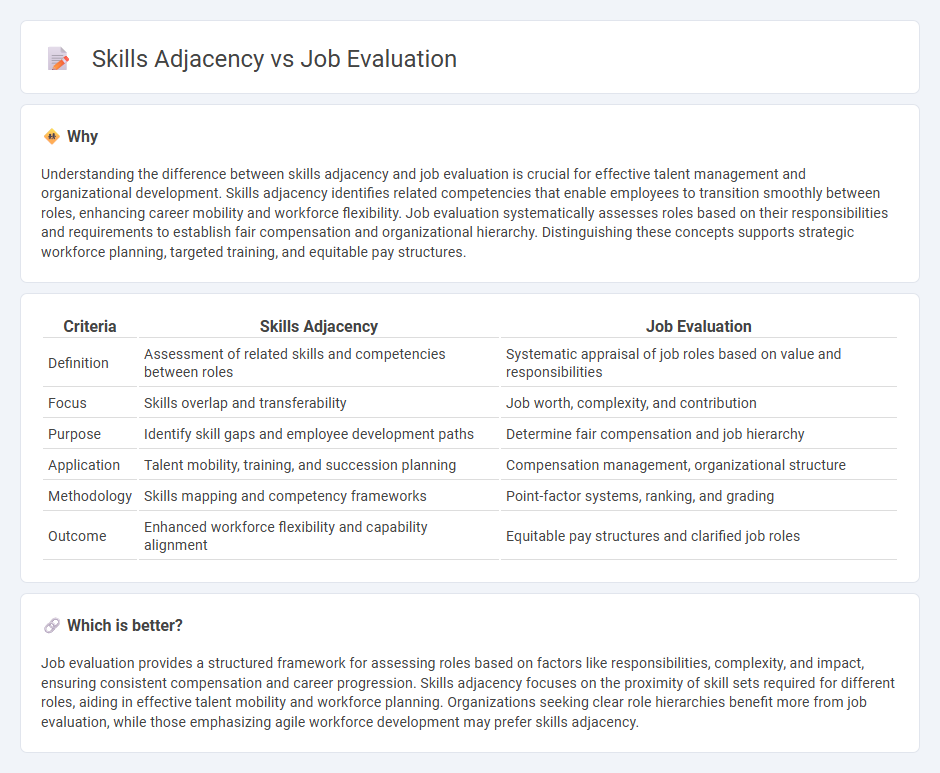
Skills adjacency evaluates an employee's competencies relative to related skill sets, helping organizations identify potential for lateral moves and skill development opportunities. Job evaluation systematically assesses the relative worth of jobs within a company, guiding fair compensation and organizational hierarchy decisions. Explore more to understand how these approaches drive effective talent management.
Why it is important
Understanding the difference between skills adjacency and job evaluation is crucial for effective talent management and organizational development. Skills adjacency identifies related competencies that enable employees to transition smoothly between roles, enhancing career mobility and workforce flexibility. Job evaluation systematically assesses roles based on their responsibilities and requirements to establish fair compensation and organizational hierarchy. Distinguishing these concepts supports strategic workforce planning, targeted training, and equitable pay structures.
Comparison Table
| Criteria | Skills Adjacency | Job Evaluation |
|---|---|---|
| Definition | Assessment of related skills and competencies between roles | Systematic appraisal of job roles based on value and responsibilities |
| Focus | Skills overlap and transferability | Job worth, complexity, and contribution |
| Purpose | Identify skill gaps and employee development paths | Determine fair compensation and job hierarchy |
| Application | Talent mobility, training, and succession planning | Compensation management, organizational structure |
| Methodology | Skills mapping and competency frameworks | Point-factor systems, ranking, and grading |
| Outcome | Enhanced workforce flexibility and capability alignment | Equitable pay structures and clarified job roles |
Which is better?
Job evaluation provides a structured framework for assessing roles based on factors like responsibilities, complexity, and impact, ensuring consistent compensation and career progression. Skills adjacency focuses on the proximity of skill sets required for different roles, aiding in effective talent mobility and workforce planning. Organizations seeking clear role hierarchies benefit more from job evaluation, while those emphasizing agile workforce development may prefer skills adjacency.
Connection
Skills adjacency enhances job evaluation by identifying related competencies that streamline role comparisons and workforce planning. Precise job evaluation relies on mapping overlapping skills to assess job complexity and value accurately. Effective integration of skills adjacency enables organizations to optimize talent deployment and align compensation structures.
Key Terms
Compensation
Job evaluation systematically assesses roles based on factors such as responsibilities, complexity, and impact to determine fair compensation structures. Skills adjacency emphasizes related skill sets and proficiency levels, aligning pay scales with employees' capabilities and potential growth within job families. Explore strategies integrating both approaches to optimize compensation frameworks effectively.
Competency Mapping
Job evaluation systematically assesses roles based on factors like responsibilities, skills, and market value to determine appropriate compensation and hierarchy within organizations. Skills adjacency in competency mapping identifies related or transferable skills that enhance employee development and career progression by recognizing overlapping competencies across different roles. Explore in-depth strategies to leverage job evaluation and skills adjacency for optimized competency mapping and workforce planning.
Role Benchmarking
Role benchmarking provides a structured framework to compare job roles by evaluating their responsibilities, scope, and required competencies, ensuring accurate job evaluation across organizations. It emphasizes objective assessment over subjective skill adjacency, aligning roles with market standards and organizational strategy. Explore deeper insights into how role benchmarking transforms talent management and compensation structures.
Source and External Links
Job Evaluation: Your 2025 Guide [+ Free Template] - This guide provides an overview of job evaluation methods, including qualitative and quantitative approaches, to determine the relative value of different jobs.
What Is a Job Evaluation? Definition, Methods and Process - Job evaluations help determine equitable pay by comparing job responsibilities to ensure salaries align with the work's value.
Job Evaluation Guide - This guide outlines the process of conducting a job evaluation through job analysis to classify positions based on duties and responsibilities.
 dowidth.com
dowidth.com